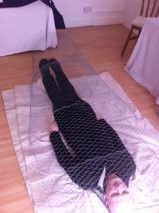A week of intensive work on “Angel’s Nightie” in the studio: both making and thinking. Following on from thinking about the quote from “the Tempest” (Shakespeare) in previous blog, I took my daughters to see the Alexander McQueen show (my third visit) on their INSET day.
Whereas on previous visits I’d been particularly taken by the Dark Romanticism pieces for which I felt a lot of affinity and love, this time round I felt myself drawn to the last exhibit, from his last show “Plato’s Atlantis” (2010), which tied in with my interest in taking the chrysalis-bodybag piece beneath the waves and into “the liquid life”. An idea of death as less ashes to ashes, dust to dust (although there will be that too, perhaps) and more a return to the sea. Both in an individual sense, but also in an evolutionary sense.
Afterwards we went over to the Natural History Museum and in the Museum shop I bought a book about Marine Invertebrates, called “Spineless”: full of beautiful imagery; several years worth of inspiration.
On the way home after picking up my daughters from school towards the end of the week, me covered in plaster, having done a few rows of knitting in the school playground (finding time to fit everything in), my eldest asks me: How is the chrysalis-bodybag thing going, Mummy? and I tell her: it’s no longer just a Chrysalis-bodybag. It’s becoming other things as well. I’m trying to merge the idea of chrysalis-butterfly with bodybag with sea cucumber with influences from Alexander McQueen and Shakespeare with death and ashes and pigeon wings. And meld them all together and knead them and knead them (We’ve been watching old episodes of the Great British Bake-off together) until the “dough-of-ideas” becomes less sticky and becomes itself. In the car she asks me to tell her all the ingredients again, that she wants to write them down. I do, telling her not to worry about getting the spellings right, that not even Shakespeare really knew how to spell his own name and she compiles a list in her note book and by the end of the journey has merged and jumbled all the words together, taking a part from each, into one incredibly long and strange word.





























